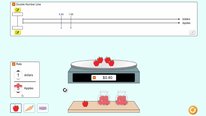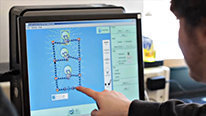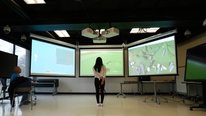- Kathy Perkins
- http://www.colorado.edu/physics/EducationIssues/about/people.htm
- Director
- Presenter’s NSFRESOURCECENTERS
- PhET Interactive Simulations, University of Colorado Boulder
- Stephanie Chasteen
- http://www.sciencegeekgirl.com/bio.html
- multimedia director
- Presenter’s NSFRESOURCECENTERS
- University of Colorado Boulder
Facilitators’, Presenters’,
& Public Choice
PhET Interactive Simulations
NSF Awards: 1020362
2015 (see original presentation & discussion)
Grades 6-8, Grades 9-12, Undergraduate
PhET provides fun, free, interactive, research-based science and mathematics simulations. We extensively test and evaluate each simulation to ensure educational effectiveness. These tests include student interviews and observation of simulation use in classrooms. The simulations are all open-source, written in Java, Flash or HTML5, and can be run online or downloaded to your computer. This video gives a brief introduction to our project.
Science, Emerging Technologies, Design and Development
PhET Interactive, CU Boulder
Discovery Research PreK-12 (DRK-12)
Related Content for PhET Interactive Simluations: An Overview
-
 2017PhET Simulations and Auditory Descriptions
2017PhET Simulations and Auditory Descriptions
Emily Moore
-
 2016Accessible PhET Simulations
2016Accessible PhET Simulations
Emily Moore
-
 2017Teaching and Learning Math with PhET Simulations
2017Teaching and Learning Math with PhET Simulations
Kathy Perkins
-
 2017Making STEM More Accessible with Sonified PhET Simulations
2017Making STEM More Accessible with Sonified PhET Simulations
Bruce Walker
-
 2019Transforming Math Classrooms with PhET Simulations
2019Transforming Math Classrooms with PhET Simulations
Kathy Perkins
-
 2018Geniventure: Explore genetics with an intelligent tutor
2018Geniventure: Explore genetics with an intelligent tutor
Kiley McElroy-Brown
-
 2017ELASTIC3S
2017ELASTIC3S
Robb Lindgren
-
 2017SageModeler, a Student-Centered System Modeling Tool
2017SageModeler, a Student-Centered System Modeling Tool
Daniel Damelin
This video has had approximately 4,815 visits by 4,293 visitors from 936 unique locations. It has been played 1,945 times as of 05/2023.
Map reflects activity with this presentation from the 2015 Teaching & Learning Video Showcase website, as well as the STEM For All Multiplex website. 
Based on periodically updated Google Analytics data. This is intended to show usage trends but may not capture all activity from every visitor.
show more
Discussion from the 2015 Teaching & Learning Video Showcase (78 posts)


Brian Drayton
Oh, hurrah. The PhET materials are just great!
Kathy Perkins
Director
Thanks, Brian!
Jackie DeLisi
Research Scientist
These look like really engaging materials that are clearly enjoyed by students and teachers alike. What has been some of the results of your testing? Also, do you provide any other materials to support classroom use of these simulations?
Kathy Perkins
Director
Hi Jackie, Thanks for your quesetions.
Yes, we provide classroom materials at both the college and K-12 levels – those developed by us as well as materials contributed by teacher users. You can browse the materials and see our teacher PD videos and materials here: http://phet.colorado.edu/en/for-teachers
We’ve engaged in research in a number of contexts – lecture, lab, inquiry-based tutorials, etc. – as well as studying design through interviews. We cannot research every sim due to resources, but we test every sim with students. You can see our research papers here: http://phet.colorado.edu/en/research
We’ve studied simulation design quite a bit, and focused on an approach we call implicit scaffolding – that is scaffolding through the design of the sim.
Some other interesting recent findings: In one study, we investigated how varying guidance in a sim-based activity worksheet impacted student engagement. Less guidance produces more engagement with the sim. In another study, we investigated how the students in a large lecture interacted with the sim and the nature of their discussion during an initial free-exploration time of about 10 minutes, and demonstrated that the implicit saffolding in the sim engaged students in productive on-task exploration and investigation. In another study, we demonstrated learning of coefficients and subscripts in a chemical formula by 5th graders – a difficulty that persists through college. More are at the weblink!
Randy Kochevar
Senior Research Scientist
What a great resource! I was wondering what a typical “use case” is for these. Do teachers use them singly, or is it more typical for a teacher to use several of them in progression?
Kathy Perkins
Director
Hi Randy,
We really try to make these flexible tools – so there is no dominant use case. We did a survey a couple of years ago and got over 3000 responses. Results are in a 2014 PER Conference proceedings paper which should be out soon. Teachers used these in many different ways – hands-on inquiry, in labs, front of room demos or discussions, with clicker questions. Some teachers use just a few, and others use 20+. You can see an example of how these can work together in one course here – showing the sim and the type of use: http://phet.colorado.edu/files/guides/Planning/...
Ben Sayler
Professor of Physical Science and Mathematics
These look fantastic. I’m curious about your process for developing a new simulation. How do you identify topics? What types of expertise do you engage in development and review? What tends to be tricky in creating effective simulations?
Kathy Perkins
Director
Hi Ben,
Great questions. We look to address topics/concepts that are challenging for students (e.g. research has established student difficulties) and which can really benefit from the affordances the simulation can offer (e.g. multiple representation, immediate feedback, showing the invisible, etc.). To develop a sim, we form a sim team which has a content expert, one or more teachers who teach the content to the target audience, and very importantly, a sim interface design expert (someone who knows a lot about how students interact with sims). One person is the sim lead, and responsible for the team progress, and also pulls in other stakeholders as needed. The software developer is also a member of the design team – and participate throughout the design and development process. We storyboard each sim. The most critical steps are to think carefully about the learning goals you are trying to achieve, and then about how the interaction with the sim will help support students in discovering and building those ideas/concepts. The interaction-feedback connection is absolutely critical. And for every sim we do student interviews, to make sure the students are engaged, exploring, having no trouble with usability, and importantly that their natural flow and interaction with the sim leads to learning the content ideas. We’ve written a number of papers about design, if you are interested.
Ben Sayler
Professor of Physical Science and Mathematics
Sounds like a wonderfully robust process. Thanks!
John Adowah
Thanks to you Ben and Kathy for the question and the explanation.
Kathy I would be grateful to have those papers about Sim design.
Kathy Perkins
Director
Hi John,
You can find our papers about sim design here: http://phet.colorado.edu/en/research
Suzanna Loper
One thing that is wonderful about this project is the breadth of sims that have been created. In our work with teachers, almost every middle school science teacher I talk to has heard of PHET. It was exciting to see the global impact as well!
Stephanie Chasteen
multimedia director
Thanks, Suzanne! We have been expanding our work in middle school recently, it’s great to hear that you’re finding a lot of people are aware of the sims. We have a new set of videos on the use of the simulations in K12 as well; see http://phet.colorado.edu/en/for-teachers/tipsFo... for tips on using and designing activities for K12. More coming…
Bryson Dalgleish
The simulations are fantastic… I use them every day with my 7-10 Grade classes at a bilingual (German, English) school in Berlin , Germany.
I usually start by tweaking a worksheet available on the Phet site but, thanks to excellent constructive feedback from my students, I am constantly improving the way I use the sims. I’ll try and find some time soon to upload my “tweaked worksheets” to the Phet site. Meanwhile you can view them on my website www.els724.com.
Keep up the good work.
cheers
Bryson Dalgleish
Stephanie Chasteen
multimedia director
Thanks, Bryson; yes, please do find the time to upload your activities. Our activity database is a really excellent resource for other educators.
Jack Gittinger
I teach a general science course for preservice elementary (K-6) teachers. The PHET simulations are not only excellent resources for teaching the content of this course, but, used appropriately, they serve as excellent models of using simulation to engage learners in inquiry and the scientific method.
Stephanie Chasteen
multimedia director
Yes, Jack, we really do advocate using the simulations for these sorts of “process” goals, they are designed to support these kinds of inquiry/investigation goals. Our video on Designing Activities for K12, http://phet.colorado.edu/en/for-teachers/tipsFo..., has some ideas for using the sims in this way, for those of you who would like more info.
Janice Gobert
Hi Kathy, what types of assessment are you doing associated with PhET sims?
Janice
Kathy Perkins
Director
Hi Janice, We have a few threads of research that have looked at the sims impact. We do some classroom based assessments where we give pre/post tests to examine student learning around sim-based activities. We’ve also done studies where we contrast instructional approaches – sim vs real world equipment, sim vs no sim with clicker questions, sim vs no sim in tutorials. We also do studies around sim design through interviews. What we haven’t done, and would be great to do if we had resources/partners for it, would be a large scale study to examine sim vs business as usual instruction, or another interesting contrast, on a larger scale. We’ve also done assessments about students and teachers attitudes around the simulations.
We have some work beginning in collaboration with other researchers that focuses on using the sims as part of next-generation assessments. The HTML5 sims will be more useful for this as they will have enhanced versions that support back-end data and an API for configuration and interchangeability with other technologies/wrappers.
Henrique Sander
The PhET simulations are an amazing way of learning and studying. The site is great for students and teachers.
Stephanie Chasteen
multimedia director
Thank you Henrique!
EDWIN GUTIERREZ
LAS APLICACIONES SON MUY INTERESANTES, PARA LOS ESTABLECIMIENTOS EDUCATIVOS QUE CARECEMOS DE LABORATORIOS, ES UN MATERIAL DE GRAN VALOR
Jenny Snyder
I’m a 12th grade teacher. My students and I love pHet. I use the Glaciers, greenhouse gasses and plate tectonics models. I used teacher materials from the site. We can test ideas on pHet not possible in the classroom.
Stephanie Chasteen
multimedia director
Excellent, Jenny, thanks!
Bob Aikenhead
Great to see PhET getting recognition and commendations. I used these when they first came online with senior high school students here in Victoria (Australia); and have since used them regularly with tertiary undergraduates (science and in science units for non-science stream) as well as in a post-grad course of pre-service training for aspiring high school physics teachers. The existence of support materials is important for the latter group as a starting point for their own uses of PhET.
Kathy Perkins
Director
Thanks, Bob! It’s great to hear about all of theses contexts in which you have been able to use PhET in your work. We’ll be updating our website soon, to make the sim-based activities more apparent to new educators visiting the site.
Linda Singley
Thank you and keep up the good work! Very applicable to HS classes in chem and physics. Engage the students and allow questioning from the students to guide the learning.
Kathy Perkins
Director
Thanks, Linda. It’s great to hear that you are using the sims in this way – to allow the students’ questions to guide the learning. I love it.
Dr Nkwenti
These simulations are awsome! They make learning very interactive. Kudos to the team of developers
Kathy Perkins
Director
Thanks, Dr. Nkwenti!
rolly dominguez
great materials for science
Kathy Perkins
Director
Thanks, Rolly. So glad you find them useful for your work.
rolly dominguez
great materials for science
John Adowah
Hi Cathy, judging from the geographical area I am coming from it’s a very useful teaching tool. I have been using the sim for the past five years.How may I contribute my ideas also towards of this wonderful project ?
John -Ghana
Kathy Perkins
Director
Hi John, Thank you for joining us from Ghana! There are many ways you can contribute, depending on your inclinations. You can:
- upload your sim-based lessons to our activity database to share with other teachers
- disseminate the simulations to schools without internet by downloading the entire website (our installer) to a thumbdrive and bringing the resources to other schools there.
- give local workshops around teaching with PhET (we have workshop materials available from our website, and we can give you some tips via email if you have questions)
- submit ideas for new sims or bugs or anything, to phethelp@colorado.edu
- translate the simulations into new languages — if there are rural langugages that would be useful for your region.
Are any of these areas where you would like to contribute?
chuleenee Pahurat
PhET interactive simulations have been a good choice for my class, high school physics, for many years. They encourage my students to deeper though in each simulation. Although they are not such real experiments, my students were enjoy and excited as well. So, thank you PhET’ s team work.
Kathy Perkins
Director
Thanks, Chuleenee. It’s great to hear you find they encourage deeper learning.
John Connell
I love PhET for my HS Physics class! I usually use Universal Gravitation and DC circuits. One thing I would like to see is a little random error built in :)
Kathy Perkins
Director
Hi John, Thank you for the suggestion. Interestingly, one of our research collaborators is doing a small experiment around just that question. Where we introduced some noise into the voltage measurement in circuit construction kit. We’ll see how that impacts student interaction and learning.
Shari Hiltbrand
I have been using PhET for years (since they first came out). It was a great discovery. It’s a great way to get students into concepts through safe inquiry and discovery then moving to hands on applications from there. The addition in the last few years of printed resources as an accompaniment to the activities has been fantastic. PhETs help take the teacher out of the center stage position and let the learning be more focused on the student. The teacher can be more of a learning coach and less of the “sage on the stage.” I have been teaching 28 years and use these on a regular basis with my middle school students. And PhET is working diligently to convert to HTML5 to allow for use on any format. Great job, PhET and thanks for your dedication to Science Education.
Kathy Perkins
Director
Thank you, Shari, for sharing your experiences! It’s great to hear that the sim-based activities and conversion to HTML5 have been particularly useful for you. We’ll keep working on the HTML5 conversions. Are there other areas where you see some investment by our team would help teachers use PhET?
If you also design your own lessons, we would love to see them uploaded to the activity database!
Lisa Love
PhET are amazing. I also like the teacher docs for the most part. I can download them and edit them for my needs in my classes. Also great for creating diversified teaching. So much thanks to you for these!
Lisa – Teacher at Filer High in Filer, Idaho
Kathy Perkins
Director
Thank you, Lisa, for sharing. It’s great to hear that you find it useful to be able to edit the lessons/activities. We have always felt that even if we design a lesson, teachers will need to be empowered to customize it for their context so I’m glad to hear you appreciate that capability.
If you make improvements or modify for a different level, please consider uploading them back to the website. Thanks!
Randy Kilian-Smith
I work with teachers in primarily rural areas. I promote PhET everywhere I go for teachers to utilize in whole group instruction and in group or individual inquiry. They provide such a strong dimension of learning that many of the school do not have the budgets to purchase and maintain equivalent equipment. Thanks to all at PhET for all your efforts and what you might bring us in the future.
Kathy Perkins
Director
Thanks, Randy. It’s great to hear that these are benefiting the rural schools. That is certainly a goal for the team!
Jelena
Хвала.
Hvala.
Köszönöm.
Thank you.
Scott Lewis
Congratulations to Stephanie, Kathy, and everyone involved with PhET. The video mentions that new simulations are being developed in biology, earth sciences, and math. Are there any plans for simulations in social sciences as well?
Kathy Perkins
Director
Hi Scott, We don’t have plans yet for social science simulations, but I can see how our design approaches could work well for some areas – like microeconomics, for instance. If you have ideas, send them along to phethelp@colorado.edu, and perhaps down the road we’ll look for a social science content/education expert who wants to partner on a project around this topic.
Jacqueline Miller
The PhET chemistry simulations are the best simulations for being truly interactive and in supporting deeper understanding of difficult, abstract concepts. I can’t wait for more biology! Thanks.
Kathy Perkins
Director
Hi Jackie! Thanks for your comments. From the few simulations we have done in biology, biology is a much harder design. We learned a lot doing a few, and I think we can design some good ones in partnership with biology content/education experts, but its definitely harder than physics, chemistry, or math. Biology concepts have more of a story-line and more complex behavior, and the “why” of the ideas is often harder to represent. But we will love the challenge, when the time hopefully comes someday and we can invest resources in biology sims.
Phakathi Moyo
I used the PhET simulations and they are excellent! They are a must have for Science educators and learners alike.
Kathy Perkins
Director
Thanks, Phakathi!
Carina Eizmendi
I love these simulations! Some I’ve used as in-class demos on the projector, some that are really fun and pertinent to my classes (e.g. Skate Park) I’ve written up into labs for when we have full-class computer time. I’m glad PhET is updating to HTML5 too. SO much better and interactive than other so-called simulations that are really just chains of animations with a lecture. Worked well for advanced students as well as struggling students, and even alternative ed. students with violence and other behavioral problems. Thanks for making them! Make more!
Kathy Perkins
Director
Hi Carina, Thank you for sharing about your usage. It’s especially valuable to hear about the large range of students you’ve used them with – advanced students to those struggling students with behavioral problems.
Timy, Prizren_Kosovo
I am a high school physics teacher in Prizren, Kosovo.
Since the first time I have seen PhET Colorado Interactive Sumulations, I am fascinated by the possibility that offers computer technology in education system. So I immediately started to apply this form of learning with my students. They have remained very glad, that for a moment they started to applaud from excitement.
I’m not a developer of applications, but in the future I will try to contribute to PhET Colorado simulations, with any application as well with financial contribution.
Kathy Perkins
Director
Thank you, Timy! Great to hear about your use. One way you may want to contribute is by uploading sim-based lessons and activities that you use, for other teachers in your country to access. When you upload an activity, you can tag it with a language. Thanks again for sharing.
Beth Sanzenbacher
We use PhET sims in our middle school classes and they are amazing at helping students grasp complex concepts in a very playful way. Keep up the good work!
Many of our students wish they were games or had some type of gaming aspect to them.
Kathy Perkins
Director
Hi Beth, Thanks for the feedback and the student input on games. We’re finding that games do work quite well in the math simulations that we are building now. They are opportunities for them to be challenged and test their understanding. If you design lessons for middle school with the sims, please consider sharing back to our activity database. We would love to have more middle school activities for different content and contexts. Thanks
Beth Sanzenbacher
We have a very successful mini-unit that involves the pressure and flow sim as research to engineer a plumbing system. I’ll make sure to share it!
rolly
welcome
Robert Teese
I avoid simulations because they are unrealistic, but PhETs are so well designed that I do use them in class.
The newer PhETs also work well when embedded in Interactive Video Vignettes using our Vignette Studio software. We’ve been too busy making new videos to develop this idea further, but I am looking forward to seeing people make complete interactive online activities that combine videos, multiple-choice branching questions, video analysis and PhET simulations.
Stephanie Chasteen
multimedia director
Thanks for the comment, Robert, great to know you’ve found the sims helpful!
Kathy Perkins
Director
Hi Robert, It’s great to hear the new HTML5 sims embed nicely with your Vignette Studio. We’d be happy to help make this more seemless if you want access to the metadata. I assume you are using an iFrame to embed? Just let us know, if you need our assistance.
Kathy Perkins
Director
Oh – and down the road we are working to have the sims outfited with an API, which would allow you to hook into the data stream.
Robert Hobbs
Have used these since before 2004 (almost the beginning)! It is fantastic to have a stable applet resource. Only a few other sources maintain and update these which is so important. The quality of the PhET simulations is excellent!!
-—Can you point me to someplace that stays on top of all the changes to JAVA security so I can send my students to the most accurate instructions for keeping up with this moving target? Essentially each quarter this past year has seen an update that requires new measures be employed on the users machine.
Oliver Nix
Thanks for the comment and feedback on the sims, Robert!
The issues can vary on a case-by-case basis, but I would recommend that you have your students first update to the latest version of Java. Then provide them with a link to the latest version of the sim (you can copy the link of the ‘Run Now’ button: http://phet.colorado.edu/sims/balance-and-torqu...).
Problems can occur when using an out-of-date version of the sim even with the latest version of Java.
This should take care of most of the issues that can arise. Mac users have the added step of saving the .jar/.jnlp to their hard drive and right-clicking to open the sim. Detailed instructions for Mac here:
http://phet.colorado.edu/en/troubleshooting/mac...
Paul Nienaber
These simulations are wonderful — we use them both for homework and as part of laboratory exercises.
I’m glad you’re addressing the Java/HTML5 issues — this is a big deal for students who have non-Windows 7 platforms (and whose frustration threshold is low).
Thanks so much for all your work! Again, we use these a lot at Saint Mary’s University of Minnesota, especially for classes involving education majors.
Stephanie Chasteen
multimedia director
Excellent, Paul, please do share your activities on our activity database, if you haven’t already.
Mahdi Kamaee
Great sims! I’ve always been using PhET simulations in my classrooms and the feedback from students was great! They simply love it
Stephanie Chasteen
multimedia director
That’s so good to know, Mahdi, thanks for the support!
Lisa Hogan
I too have used PHET simulations with students. My students gained deeper conceptual understanding when they could access and use the simulations. We have recently switched from laptops to iPads. Please keep developing and converting the simulations to HTML5 so they work on iPads. I want to continue using the simulations with students using iPads!
Kathy Perkins
Director
Hi Lisa, Great to hear that you are seeing deeper understanding in your students! We’ll keep working on the HTML5 sims … as you can imagine it takes time and money, but we are doing what we can to keep them coming. In the next few weeks you will see a change to the website, with the HTML5 versions integrated into the main structure of the website – along with some new design features to help bring attention to the activities. Hope you like the changes.
Kimberle Koile
Great tools and impressive research methodology. We’ve seen the simulations used in the schools where we’ve done classroom trials with our CLP software. At some point let’s talk about how we might integrate the simulations into our electronic notebook idea.
Kathy Perkins
Director
Thanks, Kimberle. It would be great to discuss how PhET sims might integrate into your notebook idea. The new HTML5 versions are pretty easy to integrate with an iFrame, you can take snapshots, and we are adding even more advanced API technologies. So it will be a good time to discuss as we work on standardizing those features.
Emily Weiss
We love your sims and use them as a tool in our Ocean Sciences Sequence for Grades 6-8 curriculum as well. Our curriculum focuses on climate change, and the PhET Greenhouse Effect simulation, among others, has been phenomenally useful. Your sims have been very effective with our middle school, undergrad and grad students, as well as with teachers. Keep ’em coming!
Kathy Perkins
Director
Thanks, Emily. It’s great to hear about your use, and that they have been useful in your project!
Emily Weiss
We love your sims and use them as a tool in our Ocean Sciences Sequence for Grades 6-8 curriculum as well. Our curriculum focuses on climate change, and the PhET Greenhouse Effect simulation, among others, has been phenomenally useful. Your sims have been very effective with our middle school, undergrad and grad students, as well as with teachers. Keep ’em coming!
Emily Weiss
We love your sims and use them as a tool in our Ocean Sciences Sequence for Grades 6-8 curriculum as well. Our curriculum focuses on climate change, and the PhET Greenhouse Effect simulation, among others, has been phenomenally useful. Your sims have been very effective with our middle school, undergrad and grad students, as well as with teachers. Keep ’em coming!
Further posting is closed as the event has ended.